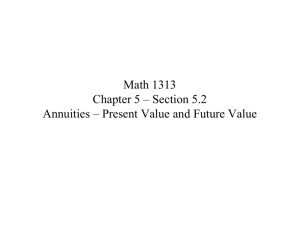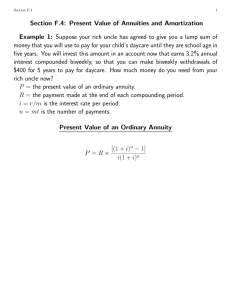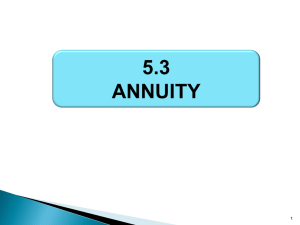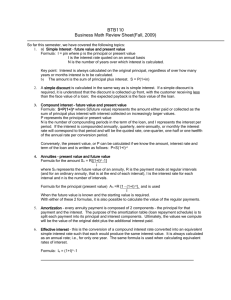Section 5.4 Annuities, Present Value, and Amortization
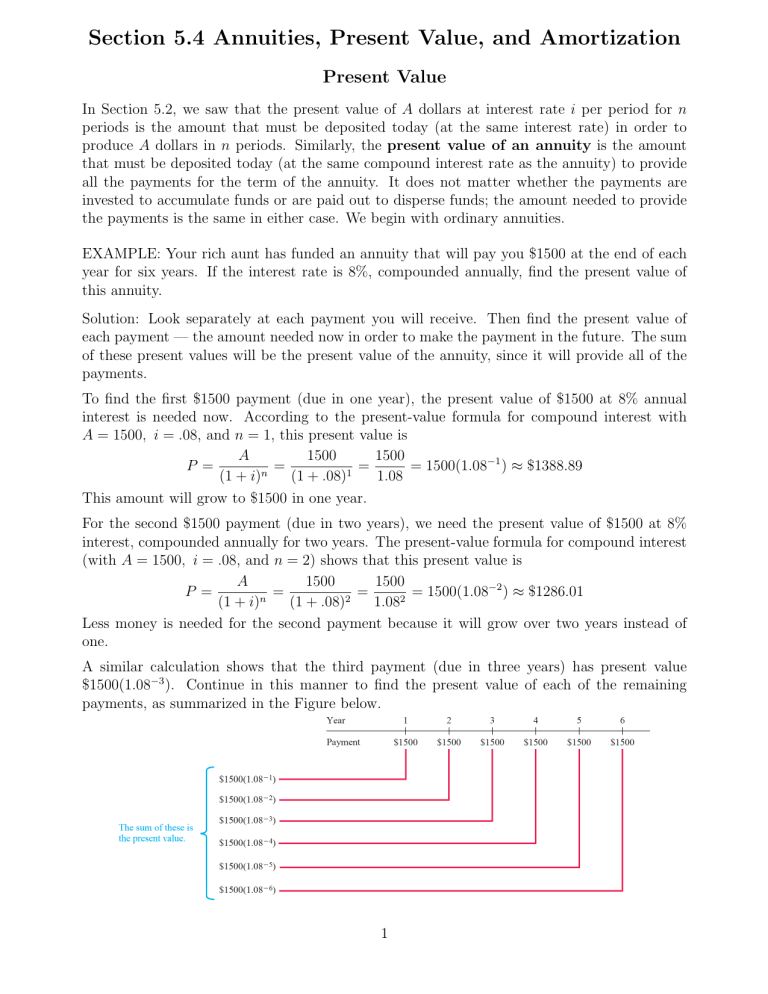
Section 5.4 Annuities, Present Value, and Amortization
Present Value
In Section 5.2, we saw that the present value of A dollars at interest rate i per period for n periods is the amount that must be deposited today (at the same interest rate) in order to produce A dollars in n periods. Similarly, the present value of an annuity is the amount that must be deposited today (at the same compound interest rate as the annuity) to provide all the payments for the term of the annuity. It does not matter whether the payments are invested to accumulate funds or are paid out to disperse funds; the amount needed to provide the payments is the same in either case. We begin with ordinary annuities.
EXAMPLE: Your rich aunt has funded an annuity that will pay you $1500 at the end of each year for six years. If the interest rate is 8%, compounded annually, find the present value of this annuity.
Solution: Look separately at each payment you will receive. Then find the present value of each payment — the amount needed now in order to make the payment in the future. The sum of these present values will be the present value of the annuity, since it will provide all of the payments.
To find the first $1500 payment (due in one year), the present value of $1500 at 8% annual interest is needed now. According to the present-value formula for compound interest with
A = 1500 , i = .
08, and n = 1, this present value is
A
P =
(1 + i ) n
=
1500
(1 + .
08) 1
=
1500
1 .
08
= 1500(1 .
08
−
1 )
≈
$1388 .
89
This amount will grow to $1500 in one year.
For the second $1500 payment (due in two years), we need the present value of $1500 at 8% interest, compounded annually for two years. The present-value formula for compound interest
(with A = 1500 , i = .
08, and n = 2) shows that this present value is
P =
A
(1 + i ) n
=
1500
(1 + .
08) 2
=
1500
1 .
08 2
= 1500(1 .
08
−
2 )
≈
$1286 .
01
Less money is needed for the second payment because it will grow over two years instead of one.
A similar calculation shows that the third payment (due in three years) has present value
$1500(1 .
08
−
3 ). Continue in this manner to find the present value of each of the remaining payments, as summarized in the Figure below.
1
The left-hand column of the Figure above shows that the present value is
1500
·
1 .
08
−
1 + 1500
·
1 .
08
−
2 + 1500
·
1 .
08
−
3 + 1500
·
1 .
08
−
4 + 1500
·
1 .
08
−
5 + 1500
·
1 .
08
−
6
= 1500(1 .
08
−
1 + 1 .
08
−
2 + 1 .
08
−
3 + 1 .
08
−
4 + 1 .
08
−
5 + 1 .
08
−
6 )
(1)
Now apply the algebraic fact that to the expression in parentheses (with x = 1 .
08 and n = 6). It shows that the sum (the present value of the annuity) is
1500
1
−
1 .
08
−
6
1 .
08
−
1
= 1500
1
−
.
1 .
08
08
−
6
= $6934 .
32
This amount will provide for all six payments and leave a zero balance at the end of six years
(give or take a few cents due to rounding to the nearest penny at each step).
The Example above is the model for finding a formula for the future value of any ordinary annuity. Suppose that a payment of R dollars is made at the end of each period for n periods, at interest rate i per period. Then the present value of this annuity can be found by using the procedure in that Example, with these replacements:
The future value in the Example above is the sum in equation (1) , which now becomes
P = R [(1 + i )
−
1 + (1 + i )
−
2 + (1 + i )
−
3 + . . .
+ (1 + i )
− n ]
Apply the algebraic fact in the box above to the expression in brackets (with x = 1 + i ). Then we have
P = R
1
−
(1 + i )
− n 1
−
(1 + i )
− n
(1 + i )
−
1
= R i
The quantity in brackets in the right-hand part of the preceding equation is sometimes written a n i
(read “ a -anglen at i ”). So we can summarize as follows.
2
CAUTION: Do not confuse the formula for the present value of an annuity with the one for the future value of an annuity. Notice the difference: The numerator of the fraction in the present-value formula is 1
−
(1 + i )
− n , but in the future-value formula, it is (1 + i ) n
−
1.
EXAMPLE: Jim Riles was in an auto accident. He sued the person at fault and was awarded a structured settlement in which an insurance company will pay him $600 at the end of each month for the next seven years. How much money should the insurance company invest now at 4.7%, compounded monthly, to guarantee that all the payments can be made?
Solution: The payments form an ordinary annuity. The amount needed to fund all the payments is the present value of the annuity. Apply the present-value formula with R = 600 , n = 7
·
12 =
84, and i = .
047 / 12 (the interest rate per month). The insurance company should invest
P = R
1
−
(1 + i i )
− n
= 600
1
−
(1 + .
047 / 12)
−
84
.
047 / 12
= $42 , 877 .
44
EXAMPLE: To supplement his pension in the early years of his retirement, Ralph Taylor plans to use $124,500 of his savings as an ordinary annuity that will make monthly payments to him for 20 years. If the interest rate is 5.2%, how much will each payment be?
Solution: The present value of the annuity is P = $124 , 500, the monthly interest rate is i = .
052 / 12, and n = 12
·
20 = 240 (the number of months in 20 years). Solve the present-value formula for the monthly payment R :
P = R
1
−
(1 + i )
− n i
124 , 500 = R
R =
1
−
(1 + .
052 / 12)
−
240
.
052 / 12
124 , 500
1
−
(1 + .
052 / 12)
−
240
.
052 / 12
= $835 .
46
Taylor will receive $835.46 a month (about $10,026 per year) for 20 years.
EXAMPLE: Surinder Sinah and Maria Gonzalez are graduates of Kenyon College. They both agree to contribute to an endowment fund at the college. Sinah says he will give $500 at the end of each year for 9 years. Gonzalez prefers to give a single donation today. How much should she give to equal the value of Sinahs gift, assuming that the endowment fund earns 7.5% interest, compounded annually?
Solution: Sinah’s gift is an ordinary annuity with annual payments of $500 for 9 years. Its future value at 7.5% annual compound interest is
S = R
(1 + i ) i n
−
1
= 500
(1 + .
075)
.
075
9
−
1
= 500
1 .
075 9
.
075
−
1
= $6114 .
92
We claim that for Gonzalez to equal this contribution, she should today contribute an amount equal to the present value of this annuity, namely,
P = R
1
−
(1 + i i )
− n
= 500
1
−
(1 + .
075)
−
9
.
075
= 500
1
−
.
1 .
075
075
−
9
= $3189 .
44
3
To confirm this claim, suppose the present value P = $3189 .
44 is deposited today at 7.5% interest, compounded annually for 9 years. According to the compound interest formula, P will grow to
A = P (1 + i ) n = 3189 .
44(1 + .
075) 9 = $6114 .
92 the future value of Sinah’s annuity. So at the end of 9 years, Gonzalez and Sinah will have made identical gifts.
The Example above illustrates the following alternative description of the present value of an
“accumulation annuity.”
Corporate bonds, which were introduced in Section 5.1, are routinely bought and sold in financial markets. In most cases, interest rates when a bond is sold differ from the interest rate paid by the bond (known as the coupon rate ). In such cases, the price of a bond will not be its face value, but will instead be based on current interest rates. The next example shows how this is done.
EXAMPLE: A 15-year $10,000 bond with a 5% coupon rate was issued five years ago and is now being sold. If the current interest rate for similar bonds is 7%, what price should a purchaser be willing to pay for this bond?
Solution: According to the simple interest formula, the interest paid by the bond each half-year is
1
I = P rt = 10 , 000
·
.
05
·
2
= $250
Think of the bond as a two-part investment: The first is an annuity that pays $250 every six months for the next 10 years; the second is the $10,000 face value of the bond, which will be paid when the bond matures, 10 years from now. The purchaser should be willing to pay the present value of each part of the investment, assuming 7% interest, compounded semiannually.
The interest rate per period is i = .
07 / 2, and the number of six-month periods in 10 years is n = 20. So we have:
Present value of $10,000 in 10 years Present value of annuity
P = R
= 250
1
−
(1 + i )
− n i
1
−
(1 + .
07 / 2)
−
20
.
07 / 2
= $3553 .
10
P = A
= 10
(1 +
, i )
− n
000(1 +
= $5025 .
66
.
07 / 2)
−
20
So the purchaser should be willing to pay the sum of these two present values:
$3553 .
10 + $5025 .
66 = $8578 .
76
4
Loans and Amortization
If you take out a car loan or a home mortgage, you repay it by making regular payments to the bank. From the bank’s point of view, your payments are an annuity that is paying it a fixed amount each month. The present value of this annuity is the amount you borrowed.
EXAMPLE: Chase Bank in April 2013 advertised a new car auto loan rate of 2.23% for a
48-month loan. Shelley Fasulko will buy a new car for $25,000 with a down payment of $4500.
Find the amount of each payment. (Data from: www.chase.com.)
Solution: After a $4500 down payment, the loan amount is $20,500. Use the present value formula for an annuity, with P = 20 , 500 , n = 48, and i = .
0223 / 12 (the monthly interest rate). Then solve for payment R .
P = R
1
−
(1 + i )
− n i
20 , 500 = R
R =
1
−
(1 + .
0223 / 12)
−
48
.
0223 / 12
20 , 500
1
−
(1 + .
0223 / 12)
−
48
.
0223 / 12
= $446 .
81
A loan is amortized if both the principal and interest are paid by a sequence of equal periodic payments. The periodic payment needed to amortize a loan may be found, as in the Example above, by solving the present-value formula for R .
EXAMPLE: In April 2013, the average rate for a 30-year fixed mortgage was 3.43%. Assume a down payment of 20% on a home purchase of $272,900. (Data from: Freddie Mac.)
(a) Find the monthly payment needed to amortize this loan.
Solution: The down payment is .
20(272 , 900) = $54 , 580. Thus, the loan amount P is $272 , 900
−
$54 , 580 = $218 , 320. We can now apply the formula in the preceding box, with n = 12(30) =
360 (the number of monthly payments in 30 years), and monthly interest rate i = .
0343 / 12.
R =
P i
1
−
(1 + i )
− n
=
(218 , 320)( .
0343 / 12)
1
−
(1 + .
0343 / 12)
−
360
= $971 .
84
Monthly payments of $971.84 are required to amortize the loan.
5
(b) After 10 years, approximately how much is owed on the mortgage?
Solution: You may be tempted to say that after 10 years of payments on a 30-year mortgage, the balance will be reduced by a third. However, a significant portion of each payment goes to pay interest. So, much less than a third of the mortgage is paid off in the first 10 years, as we now see.
After 10 years (120 payments), the 240 remaining payments can be thought of as an annuity.
The present value for this annuity is the (approximate) remaining balance on the mortgage.
Hence, we use the present-value formula with R = 971 .
84 , i = .
0343 / 12, and n = 240:
P = 971 .
84
1
−
(1 + .
0343 / 12)
−
240
( .
0343 / 12)
= $168 , 614 .
16
So the remaining balance is about $168,614.16. The actual balance probably differs slightly from this figure because payments and interest amounts are rounded to the nearest penny.
The Example above, part (b), illustrates an important fact: Even though equal payments are made to amortize a loan, the loan balance does not decrease in equal steps. The method used to estimate the remaining balance in the Example works in the general case. If n payments are needed to amortize a loan and x payments have been made, then the remaining payments form an annuity of n
− x payments. So we apply the present-value formula with n
− x in place of n to obtain this result.
Amortization Schedules
The remaining-balance formula is a quick and convenient way to get a reasonable estimate of the remaining balance on a loan, but it is not accurate enough for a bank or business, which must keep its books exactly. To determine the exact remaining balance after each loan payment, financial institutions normally use an amortization schedule , which lists how much of each payment is interest, how much goes to reduce the balance, and how much is still owed after each payment.
EXAMPLE: Beth Hill borrows $1000 for one year at 12% annual interest, compounded monthly.
(a) Find her monthly payment.
Solution: Apply the amortization payment formula with P = 1000 , n = 12, and monthly interest rate i = .
12 / 12 = .
01. Her payment is
R =
P i
1
−
(1 + i )
− n
=
1000( .
01)
1
−
(1 + .
01)
−
12
= $88 .
85
(b) After making five payments, Hill decides to pay off the remaining balance. Approximately how much must she pay?
6
(b) After making five payments, Hill decides to pay off the remaining balance. Approximately how much must she pay?
Solution: Apply the remaining-balance formula just given, with R = 88 .
85 , i = .
01, and n
− x = 12
−
5 = 7. Her approximate remaining balance is
B = R
1
−
(1 + i )
−
( n
− x ) i
= 88 .
85
1
−
(1 + .
01)
−
7
.
01
= $597 .
80
(c) Construct an amortization schedule for Hill’s loan.
Solution: An amortization schedule for the loan is shown in the table below. It was obtained as follows: The annual interest rate is 12% compounded monthly, so the interest rate per month is 12% / 12 = 1% = .
01. When the first payment is made, one month’s interest, namely,
.
01(1000) = $10, is owed. Subtracting this from the $88.85 payment leaves $78.85 to be applied to repayment. Hence, the principal at the end of the first payment period is 1000
−
78 .
85 =
$921 .
15, as shown in the “payment 1” line of the table.
When payment 2 is made, one month’s interest on the new balance of $921.15 is owed, namely,
.
01(921 .
15) = $9 .
21. Continue as in the preceding paragraph to compute the entries in this line of the table. The remaining lines of the table are found in a similar fashion.
Note that Hill’s remaining balance after five payments differs slightly from the estimate made in part (b).
The final payment in the amortization schedule in the last Example, part (c), differs from the other payments. It often happens that the last payment needed to amortize a loan must be adjusted to account for rounding earlier and to ensure that the final balance will be exactly 0.
7
Annuities Due
We want to find the present value of an annuity due in which 6 payments of R dollars are made at the beginning of each period, with interest rate i per period, as shown schematically in the Figure on the right.
The present value is the amount needed to fund all 6 payments. Since the first payment earns no interest, R dollars are needed to fund it. Now look at the last 5 payments by themselves in the Figure on the right.
If you think of these 5 payments as being made at the end of each period, you see that they form an ordinary annuity. The money needed to fund them is the present value of this ordinary annuity. So the present value of the annuity due is given by
R +
Present value of the ordinary annuity of 5 payments
= R + R
1
−
(1 + i )
−
5 i
Replacing 6 by n and 5 by n
−
1, and using the argument just given, produces the general result that follows.
EXAMPLE: The Illinois Lottery Winner’s Handbook discusses the options of how to receive the winnings for a $12 million Lotto jackpot. One option is to take 26 annual payments of approximately $461,538.46, which is $12 million divided into 26 equal payments. The other option is to take a lump-sum payment (which is often called the “cash value”). If the Illinois lottery commission can earn 4.88% annual interest, how much is the cash value?
Solution: The yearly payments form a 26-payment annuity due. An equivalent amount now is the present value of this annuity. Apply the present-value formula with R = 461 , 538 .
46 , i =
.
0488, and n = 26:
P = R + R
1
−
(1 + i )
−
( n
−
1) i
= 461 , 538 .
46 + 461 , 538 .
46
1
−
(1 + .
0488)
−
25
.
0488
= $7 , 045 , 397 .
39
The cash value is $7,045,397.39.
8



